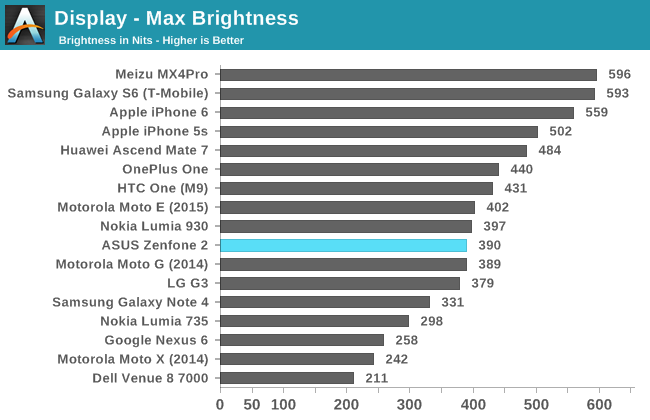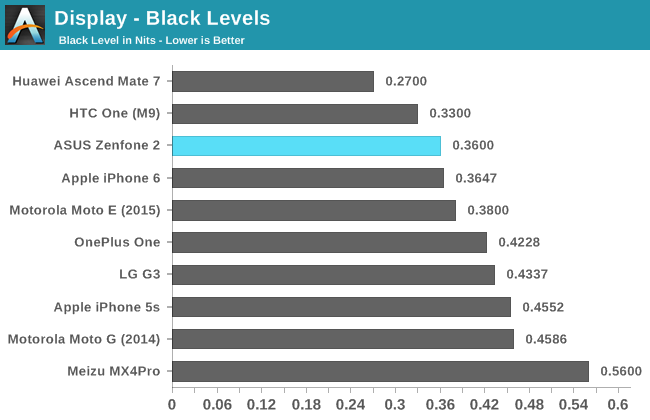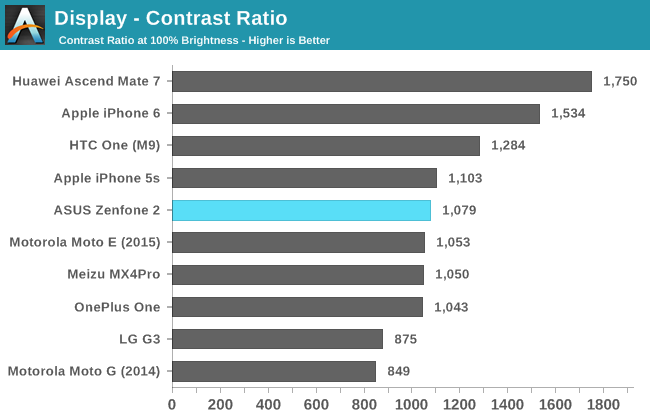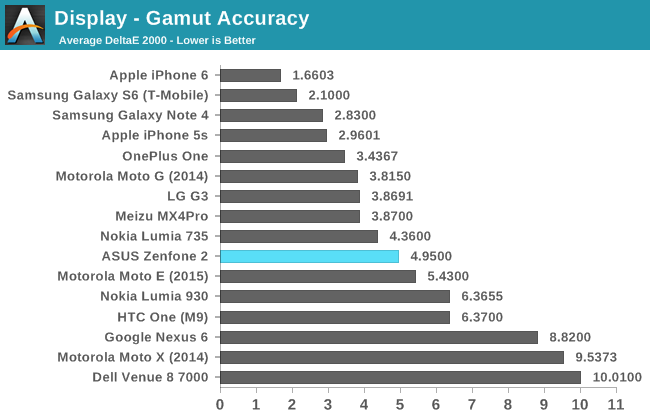The ASUS ZenFone 2 Preview
by Brandon Chester on May 18, 2015 2:00 PM ESTDisplay
I thought it would be important to give potential buyers some idea of how good the display is on the ZenFone 2. On paper it looks very good, as it's a 5.5" 1920x1080 IPS display. The pixel density isn't as high as the latest generation of 2560x1440 panels, but I find that with an RGB stripe panel the difference between 1920x1080 and 2560x1440 is minimal even at 5.5".


The ZenFone 2 appears to be off to a good start. Black levels are very low among our LCDs, and the max brightness is somewhat low but not terrible by any means. I never had any issues when using the ZenFone 2 outside, although it was definitely not as comfortable as the Galaxy S6.

The slightly low max brightness and above average black level results put the ZenFone 2 right in the middle of our LCD devices when it comes to contrast ratio.
Unfortunately, these numbers are somewhat misleading. This is because the ZenFone 2 makes extremely heavy use of dynamic contrast and contect adaptive backlighting. I have never used another device with such dramatic shifts in backlight power. The best example I've found is when switching from an all black to all white screen at max brightness. While this is obviously an extreme case, it illustrates the behavior that is occuring very well. At the moment you switch to white, the brightness of the display is around 170 nits. Over the next few seconds, that brightness rapidly increases to the 390 nits you see in the results above. This is an enormous jump in brightness, and it's very easy to see with your own eyes.
One last thing I'd like to note about the brightness is that the 100% setting on the built in brightness slider is not actually the max brightness that the display is capable of. The max you can achieve using the slider in the Settings app is 319 nits, which is around 82% of the 390 nit result you can get using applications like Brightness Adjuster from Google Play.

The gamut results are unfortunately not as good as what we've seen from the latest generation of smartphones. The DeltaE for red, blue, and magenta are all just over three, while the remaining three colors are around five. The high error in white also contributes to the higher than optimal overall error.
The complete review of the ZenFone 2 should be posted in the near future, and it will include the remainder of our display workflow. The heavy use of CABC and dynamic contrast has a large impact on the display's performance in some of our tests, and so I'll also be elaborating on where and why that occurs, and what it means for the user. For anyone who really wants to order the ZenFone 2 now, I'll conclude by saying that it's definitely not perfect, but it's still a good display. I think it's by far the nicest one you'll find on a phone that starts at $199 purely because of its resolution.











139 Comments
View All Comments
Badelhas - Tuesday, May 19, 2015 - link
I´ve read on other reviews that while it has a nice performance it´s filled with Asus BLOAT, just like their notebooks. Do you confirm this? For me, at least, thats a big letdown.Harry_Wild - Tuesday, May 19, 2015 - link
Looks great on paper! Not keen on the brush aluminum plastic case. But the price is outstanding and it 5.5" which is huge for me since I carry my phone in my front pocket and keep it there sometimes even sitting position. Not sure if you can do that in jeans like in a car seat! Looks thin enough to the iPhone 6 too! But I just purchase the Nokia Lumia 735 because of the 4.7" OLED screen and the look of the over phone. I purchase the accessories for it too; additional wireless QI battery cover, wireless charger, glass screen protector everything totaled around $400. Half the price of an iPhone!Dmcq - Tuesday, May 19, 2015 - link
I'd really like like an analysis of how the PCmark got to be so good. The possibilities I see arethe ARM big-LITTLE switch is very slow or the fast ARM's are not activated in the race to sleep the test is for, the phone has much better media for read/write and those parts of the benchmark dominated, the large memory helps the tests somehow by buffering data and not needing things compressed. There's various possibilities and the sub-parts of the test might give some indication.
Dmcq - Tuesday, May 19, 2015 - link
Found the results. The gain seems mostly to be from video editing. That has probably been heavily optimized for the test I guess! There is also a sizable gain in web browsing which might be explained by the extra memory or perhaps it is just better implemented.theMC5 - Tuesday, May 19, 2015 - link
I looked this up on Newegg, it is described as **No LTE Support in US, Canada and Mexico**. Can anyone elaborate? I'm on T-Mobile, in an area they describe as '4G LTE', so I wonder if this phone is compatible.Bob Todd - Wednesday, May 20, 2015 - link
If you go to the Asus product page they list the exact bands for the USA model in the specifications. All TMo and AT&T LTE bands are supported.Glock24 - Tuesday, May 19, 2015 - link
World be interesting to know if there's really a difference in battery life between the 2GB and the 4GB models, as some people suggest on various forums.YoloPascual - Tuesday, May 19, 2015 - link
But these intel processors drain the batteries of my zenfone 5 so fast.Michael Bay - Tuesday, May 19, 2015 - link
In their defence, you`ve got an old pre-BayTrail Atom there, and a lot has change since then.YoloPascual - Tuesday, May 19, 2015 - link
Yes I hope so that this is not an architecture problem.